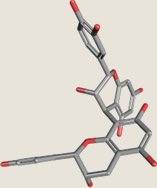 Why
use this system? Why
use this system?
Since many herb practitioners are only trained in one of these three
paradigms, frequently asked questions are:
 Why
use Western Herbs? Why
use Western Herbs?
Western herbs represent a treasure-trove of effective traditional
medicines and the collected and refined experience of practitioners
for over 2,500 years.
Three big advantages of Western herbs for people living in the Western
world are:
- availability
- safety
- power
AVAILABILITY

Angelica from a Western garden
Since they grow here in the West, they are more readily available, and
to quote Julian Scott:
“This means that the plants can be studied at first hand: the
way they grow; their preferred habitat; and the effect of climate on
their therapeutic effectiveness. All can be observed through the changes
of the seasons, often in the wild within a few miles of where one lives.
They can be gathered in the wild or grown in the garden. All this helps
to deepen one's understanding of the nature and action of a herb.”
SAFETY
Western herbs are often safer.
When herbs are grown, harvested, and processed, and tested and certified
in the West, it easier to control quality. So Western
herbs are more likely to be effective and safe.
In some countries, herbs are not always properly tested and certified.
This means that they may be the wrong species, they may be endangered
species, they may contain toxic impurities, or they may be ‘boosted’ with
potentially dangerous drugs.
POWER
There is a common error that Western herbs are weak: just a pleasant
cup of chamomile tea for Granny. People do not realize that some Western
herbs are so powerful that, in the UK, their maximum dose is regulated
by law, and their over-the-counter sales are forbidden.
Such powerful herbs include: Chelidonium, Cinchona, Convallaria, Ephedra,
Gelsemium, and Lobelia. Like most conventional medical drugs, these useful
herbs are powerful, and dangerous if not properly used. Practitioners
must be fully familiar with their dose limits and with their contraindications.
DOSE
Another common error is that people think that Western herbs are only
given in low doses, like 1-3 gram per day, so they won’t work.
Sometimes a lower dose is appropriate, but Western
herbal combinations may contain over 30 gram of herbs
for a daily dose. For example, Jeremy’s combination Althea:
gastritis contains 26
gram of herb per day.
 Why use Chinese medicine? Why use Chinese medicine?
The main problem in the practice of Western herbal medicine has been
the lack of a system of theoretical principles for choosing herbs
and for creating a balanced herb combination.
PRINCIPLES OF HERB COMBINATION
The Galenic theory system has not been in use for two centuries, and
attempts to explain herb choice in terms of either Physiomedicalism
or conventional Western medicine have not been wholly satisfactory.
Using Western herbs according to the theoretical principles of Chinese
medicine has been seen by many as the most effective way of building
balanced formulas of Western herbs. There has been a great upwelling
of interest in this system in the West, among practitioners of both
Western and Chinese herbal medicine.
CHINESE DIAGNOSTIC TOOLS
Galen’s sophisticated system of Western pulse diagnosis has
largely been forgotten. Western herbal medicine badly needs diagnostic
tools that give a more holistic picture than conventional medicine.
The powerful diagnostic tools of Chinese medicine, the system of diagnostic
questions, and pulse and tongue diagnosis, reveal the Chinese syndromes
of the patient, and hence suggest herb choice.
 Why
use the principles of Western herb tradition? Why
use the principles of Western herb tradition?
Just to apply the principles of Chinese medicine to Western herbs
is to ignore over 2,500 years of tradition of herbal theory in the
West.
 WESTERN HERB THEORY IS COMING BACK! WESTERN HERB THEORY IS COMING BACK!
Galenic medicine
Most people do not realize that a large amount of Galenic principles
remain in English and German texts, and more is being recovered. In
1651, Nicholas Culpeper wrote A Key to Galen’s Method of Physic, which is still available in print. This is a clear description of
Galen’s methods of herb prescription.
Nicholas Culpeper
Western herbal theory was very similar to Chinese medicine, and traditional
Western syndromes were very similar to Chinese syndromes. For example,
Culpeper discussed herbs to treat:
- cold in the stomach
- obstruction of the liver
- obstruction of the spleen
- obstruction of the lungs by phlegm
- depression of the heart spirit
Please read Resources: Interview: History, which is a detailed
comparison of Western and Chinese herbal theory.
IMPORTANT CONTRIBUTIONS
Western herbal theory has some very important contributions for world
herbal medicine. For example the emphasis on:
- classification according to damp and dryness
- use of (plants with) essential oils
- treatment of emotional imbalances
- use of bitter tonics and stabilizers for the nervous system
- use of bitter tonics for digestive and hepatobiliary systems
Damp and dryness
Western herbs were classified, not just in terms of temperature,
but also in terms of whether they were moistening or drying. This
is very important in treating patterns with different degrees of dryness
and damp.
For example, Culpeper classified nettles as warm and dry, and wrote
that:
“
Winter is cold and moist, so nettle tops, eaten in
the spring, consume the excess phlegm in the body that the coldness
and moistness of winter has left behind.”
Aromatic herbs
The emphasis on the use of the aromatic herbs, and the aromatic oils
in herbs, to treat mental and emotional conditions,
is much greater in Western tradition than it is in Chinese medicine.
This is the basis
of aromatherapy in the West.
Culpeper in 1651 specifically described the use of
rosemary essential oil for lethargy, mental dullness,
weak memory, and depression, but warned of the
danger of overdose.
|
|
Why use data from research?
In both China and the West, practitioners are increasingly using
data from phytopharmacological and clinical research to give them
new perspectives of herb use. Then they can treat a wider range of
modern Western disorders.
EXAMPLES
- Berberis has been reported to inhibit the multidrug resistant pumps of bacteria can be used against methicillin-resisant Staphylococcus
- Polygala has been reported to be hypolipidemic, hypotensive, and anti-ischemic has potential use to treat hyperension and atherosclerosis
- Scutellaria has been reported to be neuroprotective has potential use to treat cognitive impairment
- Scrophularia has been reported to stimulate the growth of skin fibroblasts has potential use to treat skin fragility, for example after prolonged corticosteroid treatment
EVIDENCE FOR STATEMENTS MADE
Jeremy’s first two books in his series on Combining
Western Herbs and Chinese Medicine are: Principles,
Practice, and Materia Medica and A Clinical Materia Medica: 120
Herbs in Western Use.
In these books, he gives evidence for all statements that he makes
on herb properties, actions, uses, doses, and contraindications, by
citing over 2,000 research studies and reference texts. Extensive
translations from Chinese and from German were made to gain data from
ancient and modern texts.
 Crataegus: A great Example of the Integrated System Crataegus: A great Example of the Integrated System
 Crataegus is a good example of how Western tradition, Chinese medicine,
and research all contribute to a give this herb a much wider range
of use and a greater precision of use. Crataegus is a good example of how Western tradition, Chinese medicine,
and research all contribute to a give this herb a much wider range
of use and a greater precision of use.
WESTERN TRADITION
Crataegus is an excellent example of how the use of a single herb
has changed and expanded over the centuries:
- about 100 AD in Asia minor, Dioscorides used Crataegus as an astringent to reduce diarrhea and heavy menstrual flow
- in 17th century Northern Europe it was used for kidney stone and edema, and for pain in the stomach or abdomen
- from late 19th century in United States, Crataegus was used for heart disease
CHINESE MEDICINE

Traditionally, the main uses of Crataegus in Chinese
medicine have been:
- food stagnation from excess meat or greasy
food
- Stagnant Blood with pain in lower abdomen or chest
- the partially charred fruit as an astringent for diarrhea
MODERN RESEARCH
Use of Crataegus for cardiovascular disorders. During the last 100 years, research evidence has built
up to show the effectiveness of Crataegus in the treatment
of cardiovascular disorders.
Procyanidins, such as
procyanidin B2 shown here, may contribute both to
the cardio-active effects of Crataegus, and also to
its astringency.
Actions supported by research
The following actions have been reported:
- cardiotonic
- antiarrhythmic
- diuretic
- antianginal
- cardioprotective
- antioxidant
- vasorelaxant
- hypotensive
- hypocholesteroemic
- antiatheromatic
- anti-inflammatory
- hepatoprotective
Herb-drug interactions
No negative herb-drug interactions have been reported
for Crataegus. In fact, Crataegus has been shown to
have positive herb-drug interactions. It can increase
the beneficial effects of cardiac glycoside medicines,
whilst reducing their side effects, such as arrhythmia.
BENEFITS OF INTEGRATION
Putting together the potential uses of Crataegus from
Western tradition, Chinese medicine, and modern research,
it is easy to see that the integration of the three
paradigms greatly increases the range of use of this
herb.
Crataegus has progressed over the centuries from a
secondary astringent for diarrhea and menorrhagia,
and a herb to treat food stagnation and abdominal pain,
to one of the most useful herbs in the world for the
treatment of cardiovascular diseases.
JEREMY’S CONTRIBUTION TO USE OF CRATAEGUS
In Chinese medicine Crataegus is seen predominantly
as a sour herb. This sour-astringent property can help
to firm and stabilize the energy of the body, not just
to prevent leakage of fluids, as in diarrhea, but to
stabilize mind and emotions.
It is Jeremy’s proposal that the sour-astringent
property of Crataegus may contribute to the ability
of this herb to tonify, firm, and stabilize Heart Qi.
Jeremy proposes that by reducing the fluctuations in
both the physical manifestations of Heart Qi and the
psychological manifestations of Heart Spirit, Crataegus
can help to treat fluctuations in heart function, energy,
temperature, or mood.
CRATAEGUS FOR ALL AGES
Providing that the disorder is linked to Deficiency,
Stagnation, or instability of Heart Qi, Jeremy proposes
that Crataegus can be used for:
- children with debility and hyperactivity
- teenagers with attention deficit disorder or bipolar disorders
- chronic fatigue syndrome patients
with fluctuations in energy from low
to normal (or occasionally
high)
- menopausal patients with fluctuations in temperature and emotional lability
- adults with heart pain, labile blood pressure, cardiac
arrhythmias, palpitations, or insomnia
- the elderly: for example, degenerative heart conditions
in the elderly
|
|